The Japanese Pillar Print. Hashira-e. Jacob Pins. Foreword by Roger Keyes. Robert G. Sawers Publishing, London, 1982 [LIB-1543.2018 in this collection] -> page 262 №703: A young woman dreaming of rape and robbery. 1783. Hirano.
MFA: ACCESSION NUMBER 21.5546: Young Woman Music Teacher Dreaming of a Robbery [追剥の夢を見る三味線師匠]. Edo period, about 1783 (Tenmei 3). Artist Torii Kiyonaga (1752–1815), Publisher Nishimuraya Yohachi (Eijudô). Harvard Museums Object Number 1916.586: Female Musician Dreaming of Robbery. Edo period, circa 1783. Torii Kiyonaga, Japanese (1752 - 1815) . Published by Nishimuraya Yohachi.-
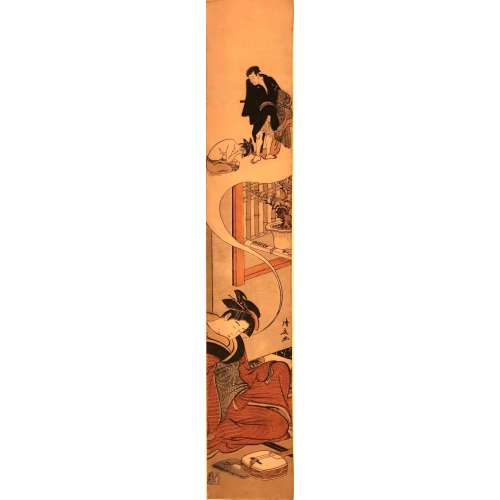 Torii Kiyonaga (1752-1815) Color woodblock print: hashira-e, 68.9 x 12.1 cm. DATE: 1783. Signed: Kiyonaga ga Publisher: Eijudō (Nishimuraya Yohachi) "Young musician dreams of being abducted by a ruffian. Long hours on duty have exhausted this young musician who sits sleeping with her shamisen and book placed on the ground in front of her. In her dream, she is being abducted by a ruffian who has stripped her of her clothing" [LIB-1474.2018: Important Japanese prints from the collection of Henry Steiner. Catalogue № 14. — NY: Sebastian Izzard LLC, 2018.]
Torii Kiyonaga (1752-1815) Color woodblock print: hashira-e, 68.9 x 12.1 cm. DATE: 1783. Signed: Kiyonaga ga Publisher: Eijudō (Nishimuraya Yohachi) "Young musician dreams of being abducted by a ruffian. Long hours on duty have exhausted this young musician who sits sleeping with her shamisen and book placed on the ground in front of her. In her dream, she is being abducted by a ruffian who has stripped her of her clothing" [LIB-1474.2018: Important Japanese prints from the collection of Henry Steiner. Catalogue № 14. — NY: Sebastian Izzard LLC, 2018.] -
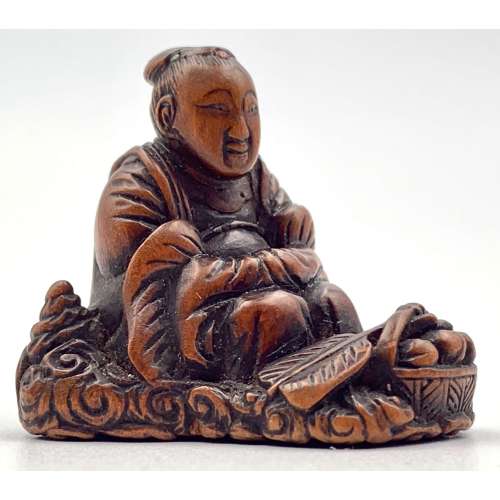 Wood netsuke of Seiōbo with a basket of immortal peaches, seated on a bed of clouds. Carver's signature tablet lost. Circa 1850. Dimensions: 32.6 x 28.1 x 20.1 mm.
Wood netsuke of Seiōbo with a basket of immortal peaches, seated on a bed of clouds. Carver's signature tablet lost. Circa 1850. Dimensions: 32.6 x 28.1 x 20.1 mm.Queen Mother of the West is a calque of Xiwangmu in Chinese sources, Seiōbo in Japan. Peaches of Immortality (Chinese: 仙桃) are consumed by the immortals due to their mystic virtue of conferring longevity on all who eat them.
Provenance: Charles Ephrussi (1849-1905) acquired in the 1870s; a wedding gift in 1898 to his cousin Ritter Viktor von Ephrussi (1860-1945) and Baroness Emilie (Emmy) Schey von Koromla (1879-1938); retrieved post-war by their daughter Elizabeth de Waal (1899-1991); given by her to her brother Ignaz (Iggie) Ephrussi (1906-1994), Tokyo; bequeathed by him to his great-nephew Edmund de Waal (born 1964), London, author of “The Hare with Amber Eyes: a hidden inheritance”. London / New York: Chatto & Windus / Farrar, Straus & Giroux. ISBN 978-0099539551. https://en.wikipedia.org/wiki/Charles_Ephrussi. https://en.wikipedia.org/wiki/Ephrussi_family. https://en.wikipedia.org/wiki/Edmund_de_Waal. -
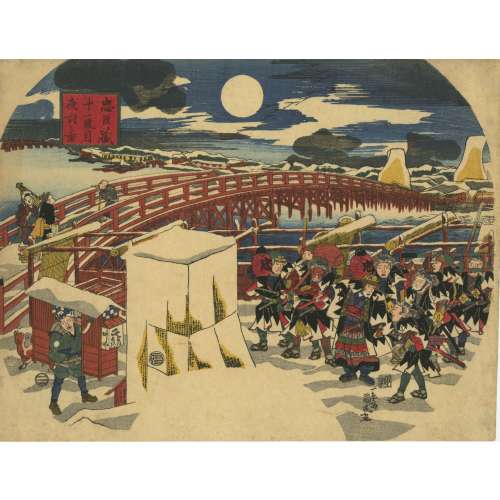 Artist: Utagawa Kunimaru [歌川国丸] (Japanese, 1794 – 1829). Publisher: Ibaya Senzaburō [伊場屋 仙三郎] (fl. 1815 – 1869). Date-kiwame seal: Bunsei 10 (1827). Signed: Ichiensai Kunimaru ga [一円斎国丸画]. Play: Chūshingura [忠臣蔵] (The Treasury of Loyal Retainers), 11th act, Night Battle [十一段目夜討之図]. Act XI: The Attack on Kō no Moronao Mansion. Kō no Moronao [高 師直] (Japanese, d. 1351). Ref: Ako City Museum of History Inscription on the soba peddler box: Nihachi soba udon [二八そば うどん] – twice eight soba and udon (16 mon per serving).
Artist: Utagawa Kunimaru [歌川国丸] (Japanese, 1794 – 1829). Publisher: Ibaya Senzaburō [伊場屋 仙三郎] (fl. 1815 – 1869). Date-kiwame seal: Bunsei 10 (1827). Signed: Ichiensai Kunimaru ga [一円斎国丸画]. Play: Chūshingura [忠臣蔵] (The Treasury of Loyal Retainers), 11th act, Night Battle [十一段目夜討之図]. Act XI: The Attack on Kō no Moronao Mansion. Kō no Moronao [高 師直] (Japanese, d. 1351). Ref: Ako City Museum of History Inscription on the soba peddler box: Nihachi soba udon [二八そば うどん] – twice eight soba and udon (16 mon per serving). -
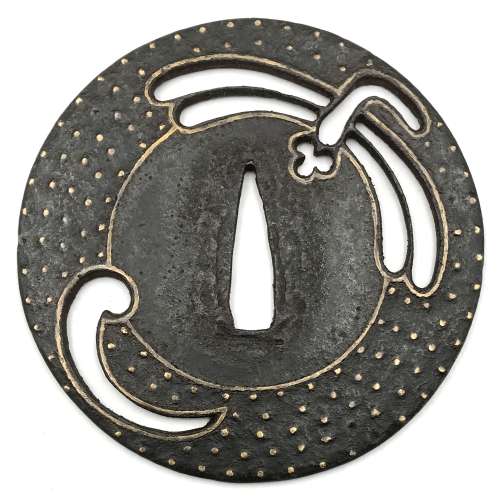 Iron tsuba of round form decorated with dragonfly (tombo) and comma (comma-like swirl, tomoe) in openwork (sukashi) outlined with brass wire. The plate decorated with 5 concentric circular rows of brass dots in ten-zōgan. Center of the plate outlined with the inlaid circular brass wire (sen-zōgan). Ōnin school. Unsigned. Mid Muromachi period, middle of the 15th century. Dimensions: Diameter: 89.5 mm, thickness: 3.1 mm. Notes regarding design: "According to various sources, the dragonfly (tombo) is emblematic of martial success, as various names for the insect are homophones for words meaning "victory". The dragonfly is also auspicious because references in the Kojiki and Nihongi link it in both name and shape to the old kingdom of Yamato." [Merrily Baird. Symbols of Japan. Thematic motifs in art and design. Rizzoli international publications, Inc., 2001, p. 108]. "The dragonfly (tonbo), was also called kachimushi in earlier times, and due to the auspicious literal meaning "victory bug" of the characters of this word it became a popular theme on sword fittings." [Iron tsuba. The works of the exhibition "Kurogane no hana", The Japanese Sword Museum, 2014, p. 13]. Helen C. Gunsaulus' description of the dragonfly emblem is as follows: "This motive, the dragon-fly (akitsu), is generally accepted as a symbol of the kingdom of Japan, and the origin of the idea is traced to the legend recounted in the Kojiki and Nihongo of the Emperor Jimmu's view of the island from mountain top. He is said to have thought the kingdom looked like a dragon-fly touching its tail with its mouth. From this it received its name Akitsu-shima... etc."
Iron tsuba of round form decorated with dragonfly (tombo) and comma (comma-like swirl, tomoe) in openwork (sukashi) outlined with brass wire. The plate decorated with 5 concentric circular rows of brass dots in ten-zōgan. Center of the plate outlined with the inlaid circular brass wire (sen-zōgan). Ōnin school. Unsigned. Mid Muromachi period, middle of the 15th century. Dimensions: Diameter: 89.5 mm, thickness: 3.1 mm. Notes regarding design: "According to various sources, the dragonfly (tombo) is emblematic of martial success, as various names for the insect are homophones for words meaning "victory". The dragonfly is also auspicious because references in the Kojiki and Nihongi link it in both name and shape to the old kingdom of Yamato." [Merrily Baird. Symbols of Japan. Thematic motifs in art and design. Rizzoli international publications, Inc., 2001, p. 108]. "The dragonfly (tonbo), was also called kachimushi in earlier times, and due to the auspicious literal meaning "victory bug" of the characters of this word it became a popular theme on sword fittings." [Iron tsuba. The works of the exhibition "Kurogane no hana", The Japanese Sword Museum, 2014, p. 13]. Helen C. Gunsaulus' description of the dragonfly emblem is as follows: "This motive, the dragon-fly (akitsu), is generally accepted as a symbol of the kingdom of Japan, and the origin of the idea is traced to the legend recounted in the Kojiki and Nihongo of the Emperor Jimmu's view of the island from mountain top. He is said to have thought the kingdom looked like a dragon-fly touching its tail with its mouth. From this it received its name Akitsu-shima... etc." -
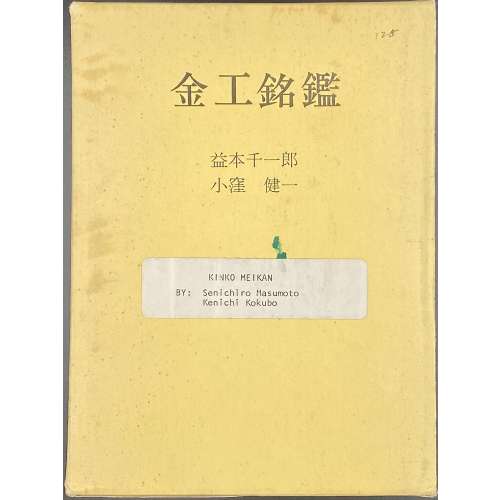 Publisher's brown cloth stamped in gilt, in a slipcase, 19 x 14 cm; pp.: [11] 1-657 [1] 1-12 [6]; in Japanese. With full English translation published in 1982 on letter-size writing paper in a separate folder, 29.5 x 23 cm, pp. [2] i-iii, 1-197, 1-52, 1-3. "Kinkō Meikan is a collection of photographs of signatures that appear on the tsuba and other fittings of the Japanese sword".
Publisher's brown cloth stamped in gilt, in a slipcase, 19 x 14 cm; pp.: [11] 1-657 [1] 1-12 [6]; in Japanese. With full English translation published in 1982 on letter-size writing paper in a separate folder, 29.5 x 23 cm, pp. [2] i-iii, 1-197, 1-52, 1-3. "Kinkō Meikan is a collection of photographs of signatures that appear on the tsuba and other fittings of the Japanese sword". -
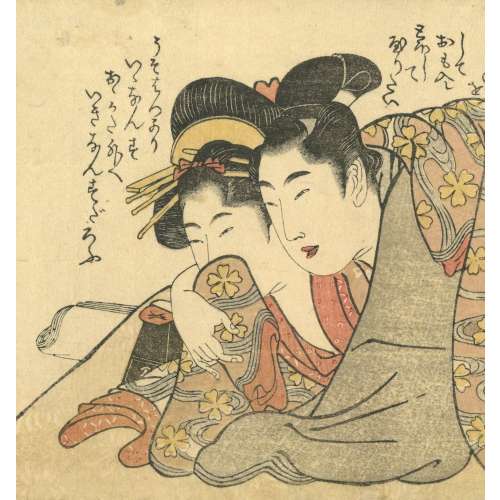 Artist: Kitagawa Utamaro [喜多川 歌麿] (Japanese, c. 1753 – 1806) "This uncommon half-size horizontal ōban ... is most likely one design from a set of twelve prints issued late in Utamaro's life" [Japanese Erotic Fantasies, Hotei Publishing, 2005, p. 143, pl. 47]. Half-size horizontal ōban must be 12.7 x 38 cm. Richard Waldman and Chris Uhlenbeck say it's tanzaku size (13 x 43 cm). In reality, the prints of this series measure 17 x 38 cm, which corresponds exactly to horizontal o-hosoban paper size. I managed to assemble 11 of allegedly 12 designs. 7 of them have genitals colored by hand. It's hard to tell whether it was done by the publisher on demand of a peculiar buyer, or by the owner of the prints who considered the black and white privy parts unnatural. My sequencing of the prints is arbitrary. Transcription of the text may help find the correct order.
Artist: Kitagawa Utamaro [喜多川 歌麿] (Japanese, c. 1753 – 1806) "This uncommon half-size horizontal ōban ... is most likely one design from a set of twelve prints issued late in Utamaro's life" [Japanese Erotic Fantasies, Hotei Publishing, 2005, p. 143, pl. 47]. Half-size horizontal ōban must be 12.7 x 38 cm. Richard Waldman and Chris Uhlenbeck say it's tanzaku size (13 x 43 cm). In reality, the prints of this series measure 17 x 38 cm, which corresponds exactly to horizontal o-hosoban paper size. I managed to assemble 11 of allegedly 12 designs. 7 of them have genitals colored by hand. It's hard to tell whether it was done by the publisher on demand of a peculiar buyer, or by the owner of the prints who considered the black and white privy parts unnatural. My sequencing of the prints is arbitrary. Transcription of the text may help find the correct order. As Japanese Erotic Fantasies put it: "a couple engaged in love-making, their stare fixed outside the picture plane". This is the only image of series that has a reference in available western literature, and the only one found in museum collections: Rijksmuseum Amsterdam (RP-P-1999-2001-16); reference: Fukuda (ed.) (1990), pls. 11-2.
As Japanese Erotic Fantasies put it: "a couple engaged in love-making, their stare fixed outside the picture plane". This is the only image of series that has a reference in available western literature, and the only one found in museum collections: Rijksmuseum Amsterdam (RP-P-1999-2001-16); reference: Fukuda (ed.) (1990), pls. 11-2.
 The scene of this print looks quite similar to that of the Kiyonaga's Sode no maki:
The scene of this print looks quite similar to that of the Kiyonaga's Sode no maki:
 The woman is "a young lady-in-waiting of Shogun's Court or Daimyō's Mansion, enjoying a rare outing from her tedious chores" [Richard Lane]. She is fully dressed in her outer cloak (shikake), white paper hat (agebōshi or tsunokakushi), and toed socks (tabi). A book or maybe, onkotogami (roll of tissues known as 'paper for honourable act' ) is still in the folds of her kimono. She is holding an open fan, either to cover her and her lover's faces from an unsolicited witness or to bring some fresh air to their joined lips. The pair just started their sexual intercourse.
The woman is "a young lady-in-waiting of Shogun's Court or Daimyō's Mansion, enjoying a rare outing from her tedious chores" [Richard Lane]. She is fully dressed in her outer cloak (shikake), white paper hat (agebōshi or tsunokakushi), and toed socks (tabi). A book or maybe, onkotogami (roll of tissues known as 'paper for honourable act' ) is still in the folds of her kimono. She is holding an open fan, either to cover her and her lover's faces from an unsolicited witness or to bring some fresh air to their joined lips. The pair just started their sexual intercourse.
 A scene from medieval times. A courtier in eboshi cap having sex with an aristocratic young woman with a long straight hairstyle (suihatsu).
A scene from medieval times. A courtier in eboshi cap having sex with an aristocratic young woman with a long straight hairstyle (suihatsu).
 Completely naked couple in the moment of ejaculation. Lavish garments with paulownia leaves on a yellow background counterbalance the white bodies on red bedding. The form of a woman's cheeks is telling, but I don't know about what. Maybe her advanced age?
Completely naked couple in the moment of ejaculation. Lavish garments with paulownia leaves on a yellow background counterbalance the white bodies on red bedding. The form of a woman's cheeks is telling, but I don't know about what. Maybe her advanced age?
 The pose of the couple and the overall composition are similar to that of the previous sheet. Though the lovers are dressed, and the woman's hairdo is well kept. The male looks older and the woman - younger.
The pose of the couple and the overall composition are similar to that of the previous sheet. Though the lovers are dressed, and the woman's hairdo is well kept. The male looks older and the woman - younger.
 A man takes a young maid from behind. She clenches the sleeve of her kimono in her teeth; it's either the moment of penetration (beginning of intercourse) or of her orgasm (the end of it).
A man takes a young maid from behind. She clenches the sleeve of her kimono in her teeth; it's either the moment of penetration (beginning of intercourse) or of her orgasm (the end of it).
 This seems to be a forced intercourse between a lackey with extensive bodily hair and a young maid from the same household.
This seems to be a forced intercourse between a lackey with extensive bodily hair and a young maid from the same household.
 This design is very much like the other one presented below, which is described at Japanese Erotic Fantasies on page 136 (pl. 43b) as follows: "The viewer peers through a mosquito net to see a child fast asleep, while his mother or wet-nurse moves towards her partner. On our print there is no child; instead of a sleeping baby, there is a roll of onkotogami. Fewer objects make the overall image concise, almost laconic in comparison with the Ehon hana fubuki (1802) design:
This design is very much like the other one presented below, which is described at Japanese Erotic Fantasies on page 136 (pl. 43b) as follows: "The viewer peers through a mosquito net to see a child fast asleep, while his mother or wet-nurse moves towards her partner. On our print there is no child; instead of a sleeping baby, there is a roll of onkotogami. Fewer objects make the overall image concise, almost laconic in comparison with the Ehon hana fubuki (1802) design:

 A young couple in a moment of true love. He is listening to the beating of her heart.
A young couple in a moment of true love. He is listening to the beating of her heart.
 This is a moment of true love between an old monk and a young samurai. The latter even did not take of his socks (tabi).
This is a moment of true love between an old monk and a young samurai. The latter even did not take of his socks (tabi).
 From Japanese Erotic Fantasies: "Boats played a crucial role in the workings of Yoshiwara, as they were the primary means of transport to the district. During the hot summer months, trips on pleasure boats were also a favourite pastime. Sex aboard a boat is a recurrent theme in shunga".
The last print that I am currently lacking and hunting for:
From Japanese Erotic Fantasies: "Boats played a crucial role in the workings of Yoshiwara, as they were the primary means of transport to the district. During the hot summer months, trips on pleasure boats were also a favourite pastime. Sex aboard a boat is a recurrent theme in shunga".
The last print that I am currently lacking and hunting for:
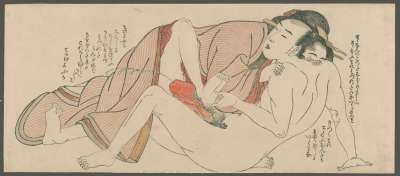 I know where it is, but I cannot reach it... yet.
I know where it is, but I cannot reach it... yet. -
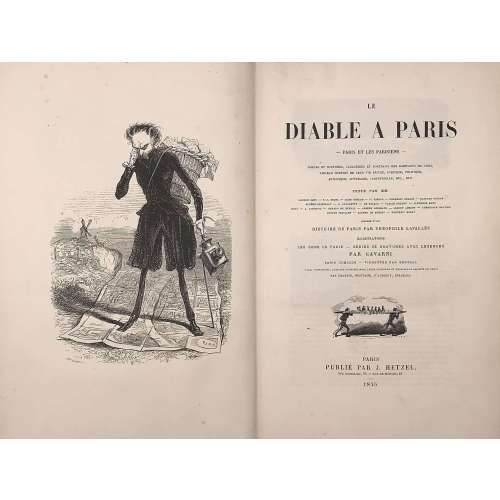
A two-volume set, published in Paris by P.-J. Hetzel in 1845 and 1846.
Vol. 1:
Title: LE | DIABLE A PARIS | — PARIS ET LES PARISIENS — | MŒURS ET COUTUMES, CARACTERES ET PORTRAITS DES HABITANTS DE PARIS, | TABLEAU COMPLET DE LEUR VIE PRIVEE, PUBLIQUE, POLITIQUE, | ARTISTIQUE, LITTERAIRE, INDUSTRIELLE, ETC., ETC. | TEXTE PAR MM. | GEORGE SAND — P.-J. STAHL — LEON GOZLAN — P. PASCAL — FREDERIC SOULIE — CHARLES NODIER | EUGENE BRIFFAULT — S. LAVALETTE — DE BALZAC — TAXILE DELORD — ALPHONSE KARR | MÉRY — A. JUNCETIS — GERARD DE NERVAL — ARSÈNE HOUSSAYE — ALBERT AUBERT — THÉOPHILE GAUTIER | OCTAVE FEUILLET — ALFRED DE MUSSET — FRÉDÉRIC BÉRAT | précédé d’une | HISTOIRE DE PARIS PAR THEOPHILE LAVALLÉE | ILLUSTRATIONS | LES GENS DE PARIS — SERIES DE GRAVURES AVEC LEGENDES | PAR GAVARNI | PARIS COMIQUE — VIGNETTES DE BERTALL | VUES, MONUMENTS, EDIFICES PARTICULIERS, LIEUX CÉLÈBRES ET PRINCIPAUX ASPECTS DE PARIS | PAR CHAMPIN, BERTRAND, D’AUBIGNY, FRANÇAIS. | [DEVICE] | PARIS | PUBLIÉ PAR J. HETZEL, | RUE RICHELIEU, 76 – RUE DE MÉNARS, 10. | 1845 ||
Pagination: ffl, [2 – h.t. / Paris: Typographie Lacrampe et Comp., Rue Damiette, 2 ; Papeir de la fabrique de sainte-marie] [2 – blank / frontis. ‘Diable’ with lantern standing on map of Paris] [2 – t.p. /blank] [I] II-XXXII, [1] 2-380, bfl. Sheet size: 27.5 x 17.5 cm.
Collation: 4to; A(4) – D(4), [1(4)] 2(4) – 47(4), 48(2); illustrations: frontispiece, vignette title-page, numerous text engravings and 99 plates.
Vol. 2: Title: LE | DIABLE A PARIS | — PARIS ET LES PARISIENS — | MŒURS ET COUTUMES, CARACTERES ET PORTRAITS DES HABITANTS DE PARIS, | TABLEAU COMPLET DE LEUR VIE PRIVEE, PUBLIQUE, POLITIQUE, | ARTISTIQUE, LITTERAIRE, INDUSTRIELLE, ETC., ETC. | TEXTE PAR MM. | DE BALZAC — EUGÈNE SUE — GEORGE SAND — P.-J. STAHL — ALPHONSE KARR | HENRY MONNIER — OCTAVE FEUILLET — DE STENDAHL — LEON GOZLAN — S. LAVALETTE — ARMAND MARRAST | LAURENT-JAN —ÉDOUARD OURLIAC — CHARLES DE BOIGNE — ALTAROCHE — EUG. GUINOT | JULES JANIN — EUGENE BRIFFAULT — AUGUSTE BARBIER — MERQUIS DE VARENNES — ALFRED DE MUSSET | CHARLES NODIER — FRÉDÉRIC BÉRAT — A. LEGOYT| précédé d’une | GÉOGRAPHIE DE PARIS PAR THEOPHILE LAVALLÉE | ILLUSTRATIONS | LES GENS DE PARIS — SERIES DE GRAVURES AVEC LEGENDES | PAR GAVARNI | PARIS COMIQUE — PANTHÉON DU DIABLE A PARIS PAR BERTALL | VUES, MONUMENTS, EDIFICES PARTICULIERS, LIEUX CÉLÈBRES ET PRINCIPAUX ASPECTS DE PARIS | PAR CHAMPIN, BERTRAND, D’AUBIGNY, FRANÇAIS. | [DEVICE] | PARIS | PUBLIÉ PAR J. HETZEL, | RUE RICHELIEU, 76 – RUE DE MÉNARS, 10. | 1846 || Pp. : ffl, [2 – h.t. / Paris: Typographie Lacrampe et Comp., Rue Damiette, 2 ; Papeir de la fabrique de sainte-marie] [2 – t.p. /blank] [I] II-LXXX, [1] 2-364, bfl. Sheet size: 27.5 x 17.5 cm. Collation: 4to; A(4) – I(4) – J(4), 1(4), 2(4) – 45(4), 46(2); illustrations: vignette title-page, numerous text engravings and 112 plates.Binding: [allegedly Roger de Coverly (British, 1831 — 1914)], 28.2 x 19 cm, ¾ brown calf ruled in gilt, brown marbled boards, nonpareil marbled endpapers, raised and ruled in gilt bands, floral devices and title lettering to spine. AEG. Foxing to flyleaves, tips of corners just a very little rubbed as are the glazed marbled paper boards; endpapers foxed; very occasional light scattered foxing of text.
Provenance: (1) Armorial bookplate (Ex Libris Sir John Whittaker Ellis, 1st Baronet (1829 – 1912), Lord Mayor of London 1881; (2) Bookplate Ex Libris Robert Frederick Green) dated 1909.
Reference: L. Carteret (1927) pp. 203-207: the first edition, lacking the publisher's white pictorial wrappers. -
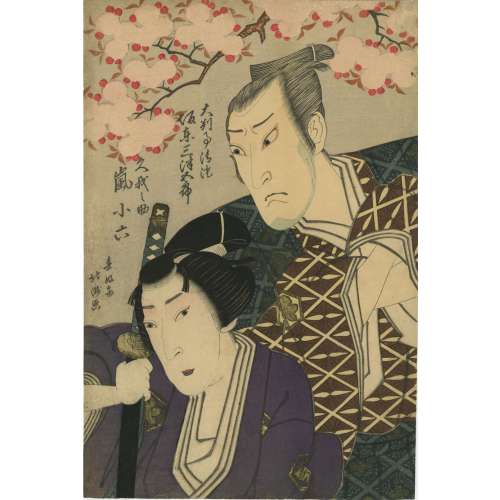 Bandō Mitsugorō III as Daihanji Kiyozumi and Arashi Koroku IV as Koganosuke in kabuki play Imoseyama, an example of womanly virtue (Imoseyama onna teikin). 大判事清澄 坂東三津五郎」(三代)・「久我之助 嵐小六」(四代) Artist: Shunkōsai Hokushū [春好斎北洲] (Japanese, fl. 1802 – 1832) Year: 1821 (3rd month). MFA description: “The Kabuki play Mount Imo and Mount Se: An Exemplary Tale of Womanly Virtue (Imoseyama onna teikin), originally based on a puppet play, is set in ancient Japan when the Soga clan served as regents to the emperor. Two children, Hinadori and Koganosuke, of rival court families, are held hostage under orders from the tyrant Soga no Iruka to ensure their families do not revolt. The children fall in love, but rather than create conflicts for their families they each vow to die by suicide. When the parents learn of their plans, they resolve to cooperate to overthrow Iruka. Here Koganosuke and his father Kiyozumi are shown; a companion sheet on the left would have shown Hinadori and her mother Sadaka.” The play Imoseyama, an example of womanly virtue (Imoseyama onna teikin), was staged at Osaka's Kado Shibai (Kadoza, Kado Gekijô, Kado no Shibai) from 3/1821. According to Herwig, it is the right sheet of a diptych (see below). MFA Accession number: 2011.128 Kabuki actors: Bandō Mitsugorō III [三代目 坂東 三津五郎] (Japanese, 1775 – 1831); other names: Bandō Minosuke I, Morita Kanjirô II, Bandō Mitahachi I, Bandō Minosuke I, Bandō Mitahachi I. Arashi Koroku IV [四代目嵐小六] (Japanese, 1783 – 1826)
Bandō Mitsugorō III as Daihanji Kiyozumi and Arashi Koroku IV as Koganosuke in kabuki play Imoseyama, an example of womanly virtue (Imoseyama onna teikin). 大判事清澄 坂東三津五郎」(三代)・「久我之助 嵐小六」(四代) Artist: Shunkōsai Hokushū [春好斎北洲] (Japanese, fl. 1802 – 1832) Year: 1821 (3rd month). MFA description: “The Kabuki play Mount Imo and Mount Se: An Exemplary Tale of Womanly Virtue (Imoseyama onna teikin), originally based on a puppet play, is set in ancient Japan when the Soga clan served as regents to the emperor. Two children, Hinadori and Koganosuke, of rival court families, are held hostage under orders from the tyrant Soga no Iruka to ensure their families do not revolt. The children fall in love, but rather than create conflicts for their families they each vow to die by suicide. When the parents learn of their plans, they resolve to cooperate to overthrow Iruka. Here Koganosuke and his father Kiyozumi are shown; a companion sheet on the left would have shown Hinadori and her mother Sadaka.” The play Imoseyama, an example of womanly virtue (Imoseyama onna teikin), was staged at Osaka's Kado Shibai (Kadoza, Kado Gekijô, Kado no Shibai) from 3/1821. According to Herwig, it is the right sheet of a diptych (see below). MFA Accession number: 2011.128 Kabuki actors: Bandō Mitsugorō III [三代目 坂東 三津五郎] (Japanese, 1775 – 1831); other names: Bandō Minosuke I, Morita Kanjirô II, Bandō Mitahachi I, Bandō Minosuke I, Bandō Mitahachi I. Arashi Koroku IV [四代目嵐小六] (Japanese, 1783 – 1826)
Ref.: [LIB-1197.2016] Arendie and Henk Herwig. Heroes of the kabuki stage: an introduction to kabuki with retellings of famous plays, illustrated by woodblock prints. — Amsterdam: Hotei Publishing, 2004; p. 72: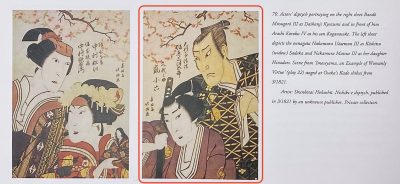
Ref: [LIB-2973.2022] Ukiyo-e: A journey through the Floating World / Exhibition catalogue (Japan, Jan-Jul 2014). — The Yomiuri Shimbun, 2014; № 358, p. 226. "Bandō Mitsugorō III as Grand arbiter Kiyosumi and Arashi Koroku IV as Koganosuke":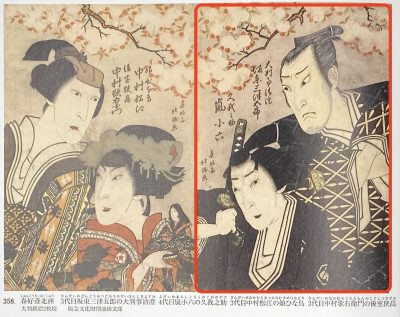
-
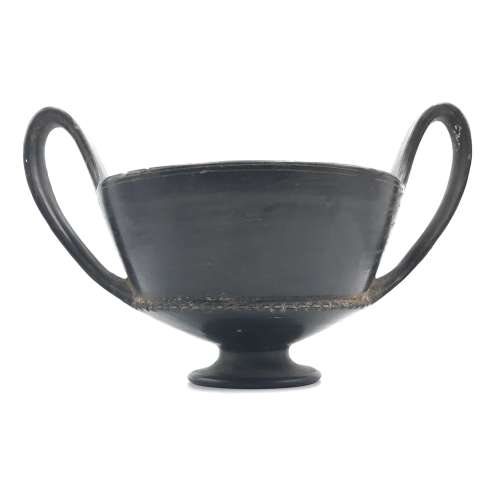 Etruscan Bucchero Pottery Kantharos, ca. 758-264 BC. A ceramic vessel with high handles, meant for consuming wine. Flanged border between the body and the foot displays dozens of incised grooves. The rim is smooth, and the upper and of each handle flows seamlessly into the body if the vessel. Bucchero is an Etruscan type of pottery named for the specific firing technique which results in a smooth, shiny black finish. Size: 21.6 x 13.3 cm. Portions os both handles repaired with some overpainting and light adhesive residue along break lines, One handle stabilized with some new material and overpainting along fissure line. Light earthen deposits within recessed areas.
Etruscan Bucchero Pottery Kantharos, ca. 758-264 BC. A ceramic vessel with high handles, meant for consuming wine. Flanged border between the body and the foot displays dozens of incised grooves. The rim is smooth, and the upper and of each handle flows seamlessly into the body if the vessel. Bucchero is an Etruscan type of pottery named for the specific firing technique which results in a smooth, shiny black finish. Size: 21.6 x 13.3 cm. Portions os both handles repaired with some overpainting and light adhesive residue along break lines, One handle stabilized with some new material and overpainting along fissure line. Light earthen deposits within recessed areas. -
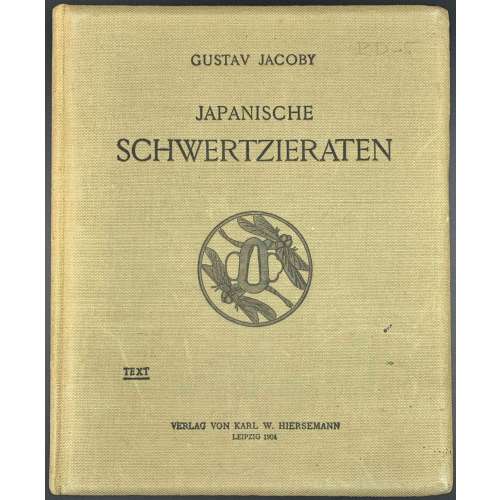
Book size: 25.5 x 21 cm. Hardbound: original olive cloth, lettering and elements on FC and lettering on Sp.
Ex Libris Dr. H. Smidt, with the motto: "Sapienti sat" and a naked bold man at the seashore, holding a fruit behind his back.
Full title: Japanische Schwertzieraten. Beschreibung einer kunstgeschichtlich geordneten Sammlung, mit Charakteristiken der Künstler und Schulen von Gustav Jacoby. Hierzu siebenunddreissig Tafeln in Heliogravüre. [The second volume, which conteined 'heliogravures' is missing and had not be found elsewhere].
-
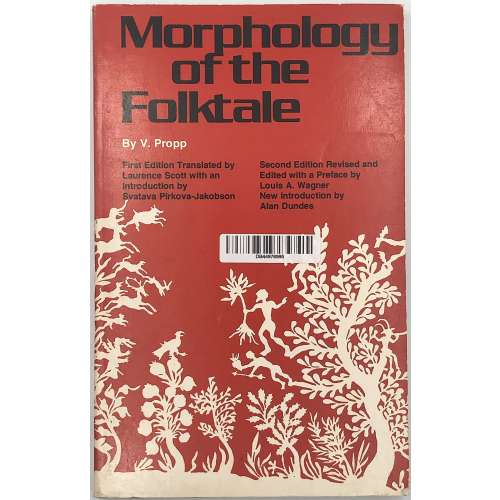 Paperback, 21.5 x 13.6 cm, red and white original wrappers with black lettering, barcode label to front, previous owner’s black ink ms to h.t. Rene Shekerjian; pp.: [i-vii] viii-xxvi[1-3] 4-158 (total 184 pp.). Title-page: Morphology | of the | Folktale | by | V. Propp | First Edition Translated by Lawrence Scott with an Introduction by Svatava Pirkova-Jacobson | Second Edition Revised and Edited with a Preface by Louis A. Warner/New Introduction by Alan Dundes | University of Texas Press • Austin and London || Serial title: American Folklore Society Bibliographical and Special Series | Volume 9/Revised Edition/1968 | [blank] Indiana University Research Center in Anthropology, Folklore, | and Linguistics | Publication 10/Revised Edition/1968 || Edition: 7th paperback printing. Contributors: Владимир Яковлевич Пропп [Vladimir Propp] (Russian, 1895 – 1970) For other editions, see [LIB-1710.2019] В. Я. Пропп. Исторические корни волшебной сказки (2-е изд.) — Л.: Изд-во ЛГУ, 1986; [LIB-3184.2023] В. Я. Пропп. Исторические корни волшебной сказки (1-е изд.) — Л.: Изд-во Ленинградского ун-та, 1946, and [LIB-1718.2019] В. Я. Пропп. Морфология сказки / Серия: Вопросы поэтики, вып. XII. — Л.: Academia, 1928.
Paperback, 21.5 x 13.6 cm, red and white original wrappers with black lettering, barcode label to front, previous owner’s black ink ms to h.t. Rene Shekerjian; pp.: [i-vii] viii-xxvi[1-3] 4-158 (total 184 pp.). Title-page: Morphology | of the | Folktale | by | V. Propp | First Edition Translated by Lawrence Scott with an Introduction by Svatava Pirkova-Jacobson | Second Edition Revised and Edited with a Preface by Louis A. Warner/New Introduction by Alan Dundes | University of Texas Press • Austin and London || Serial title: American Folklore Society Bibliographical and Special Series | Volume 9/Revised Edition/1968 | [blank] Indiana University Research Center in Anthropology, Folklore, | and Linguistics | Publication 10/Revised Edition/1968 || Edition: 7th paperback printing. Contributors: Владимир Яковлевич Пропп [Vladimir Propp] (Russian, 1895 – 1970) For other editions, see [LIB-1710.2019] В. Я. Пропп. Исторические корни волшебной сказки (2-е изд.) — Л.: Изд-во ЛГУ, 1986; [LIB-3184.2023] В. Я. Пропп. Исторические корни волшебной сказки (1-е изд.) — Л.: Изд-во Ленинградского ун-та, 1946, and [LIB-1718.2019] В. Я. Пропп. Морфология сказки / Серия: Вопросы поэтики, вып. XII. — Л.: Academia, 1928. -
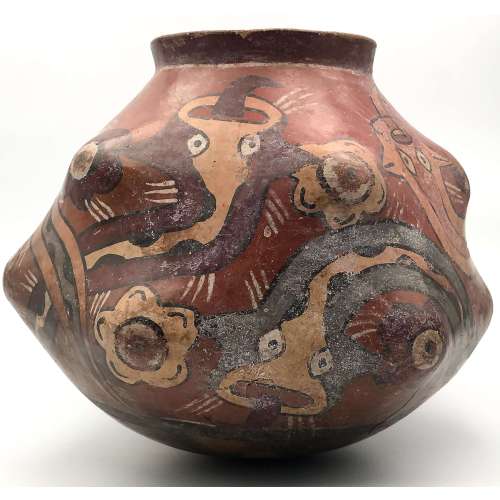
Pre-Columbian, South Coast of Peru, Nazca, ca. 22- BCE - 125 CE.Polychrome vessel of organic, phytomorphic form and thin walls finely painted with six slithering serpents and protruding floral motifs in hues of red, orange, cream, black, grey, and white.
Chips of base and rim. Pressure fissures on and a bit above the base. Surface wear commensurate with age.
Size: Diameter: 19 cm; Height: 16 cm; Mouth diameter: 8.5 cm.
-
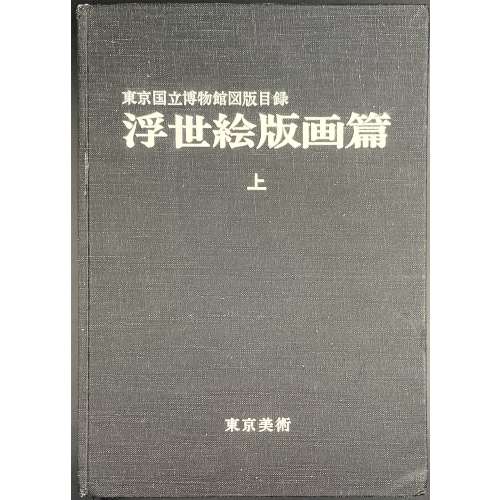 Title: Illustrated Catalogues of Tokyo National Museum: Ukiyo-e Prints [東京国立博物館図版目録 | 浮世絵版画編] (Tōkyō Kokuritsu Hakubutsukan zuhan mokuroku | Ukiyoe hanga hen); Publisher: Tokyo National Museum [東京国立博物館] (Tōkyō Kokuritsu Hakubutsukan). Three volumes, 26.3 x 18.7 cm, uniformly bound in black cloth with white characters to front cover and spine. Title-page: ILLUSTRATED CATALOGUES OF | TOKYO NATIONAL MUSEUM | UKIYO-E PRINTS | <1 (2, 3) > | 東京国立博物館図版目録 | 浮世絵版画編 | < 上 (中, 下) > || Volume 1 [上]: unpaginated 1 t.p., 2 colour plates, 1 contents, 70 (1-1354) – b/w plates, 1 + 48 paginated leaves (1-95 [96]) – text. Volume 2 [中]: unpaginated 1 t.p., 2 colour plates, 1 contents, 67 (1355-2493) – b/w plates + 33 paginated leaves (1-65 [66]) – text. Volume 3 [下]: unpaginated 1 t.p., 2 colour plates, 1 contents, 83 (2494-3926) – b/w plates + 35 paginated leaves (1-69 [70]) – text. Black and white photomechanical reproduction of almost four thousand woodblock prints with titles by the artist and in chronological order.
Title: Illustrated Catalogues of Tokyo National Museum: Ukiyo-e Prints [東京国立博物館図版目録 | 浮世絵版画編] (Tōkyō Kokuritsu Hakubutsukan zuhan mokuroku | Ukiyoe hanga hen); Publisher: Tokyo National Museum [東京国立博物館] (Tōkyō Kokuritsu Hakubutsukan). Three volumes, 26.3 x 18.7 cm, uniformly bound in black cloth with white characters to front cover and spine. Title-page: ILLUSTRATED CATALOGUES OF | TOKYO NATIONAL MUSEUM | UKIYO-E PRINTS | <1 (2, 3) > | 東京国立博物館図版目録 | 浮世絵版画編 | < 上 (中, 下) > || Volume 1 [上]: unpaginated 1 t.p., 2 colour plates, 1 contents, 70 (1-1354) – b/w plates, 1 + 48 paginated leaves (1-95 [96]) – text. Volume 2 [中]: unpaginated 1 t.p., 2 colour plates, 1 contents, 67 (1355-2493) – b/w plates + 33 paginated leaves (1-65 [66]) – text. Volume 3 [下]: unpaginated 1 t.p., 2 colour plates, 1 contents, 83 (2494-3926) – b/w plates + 35 paginated leaves (1-69 [70]) – text. Black and white photomechanical reproduction of almost four thousand woodblock prints with titles by the artist and in chronological order. -
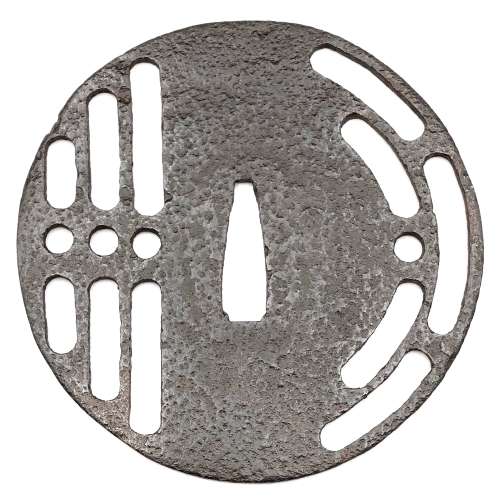 A very large and very thin iron tsuba of round form decorated with design of formalized butterfly and dragonfly in openwork (sukashi). The characteristics of the plate resemble those of Kamakura period ko-tōshō tsuba. However, the design seems too 'modern' to me, but it's hard to tell; it may be a late Muromachi or Momoyama period work. Tōshō or Ko-Tōshō school (or a Katchushi). Muromachi period. However, Boris Markhasin and Skip Holbrook insist this is a 20th-century machine-made tsuba. Dimensions: 99.6 x 100.5 x 2.1 mm. This is what Jim Gilbert says about old tsuba:
A very large and very thin iron tsuba of round form decorated with design of formalized butterfly and dragonfly in openwork (sukashi). The characteristics of the plate resemble those of Kamakura period ko-tōshō tsuba. However, the design seems too 'modern' to me, but it's hard to tell; it may be a late Muromachi or Momoyama period work. Tōshō or Ko-Tōshō school (or a Katchushi). Muromachi period. However, Boris Markhasin and Skip Holbrook insist this is a 20th-century machine-made tsuba. Dimensions: 99.6 x 100.5 x 2.1 mm. This is what Jim Gilbert says about old tsuba:"Traditionally the old iron plate tsuba are classified into Ko Tosho (old sword smith), and Ko Katchushi (old armor maker) styles. It is sometimes difficult to justify attribution of a given tsuba to the Tosho or Katchushi category. Generally guards with raised rims or relatively complex designs tend to be assigned to Katchushi. This is basically a convention we follow out of habit and convenience." [...] "In Token Kai-Shi part six, Articles by Akiyama Kyusaku, Robert Haynes comments: "…from 1300 to 1400 over 150,000 MOUNTED swords were made in Japan for export alone. This means that over four tsuba a day were made for 100 years. This would mean that at least 3000 persons were making nothing but tsuba, let alone all the other fittings needed to complete these swords. With sword smiths, fittings makers and all the other artists need to complete a sword for export, at least 10,000 sword artists were working together, in any one of these hundred years."
Another tsuba of similar design, Tōshō school, is illustrated in this collection; see TSU-0319.2015.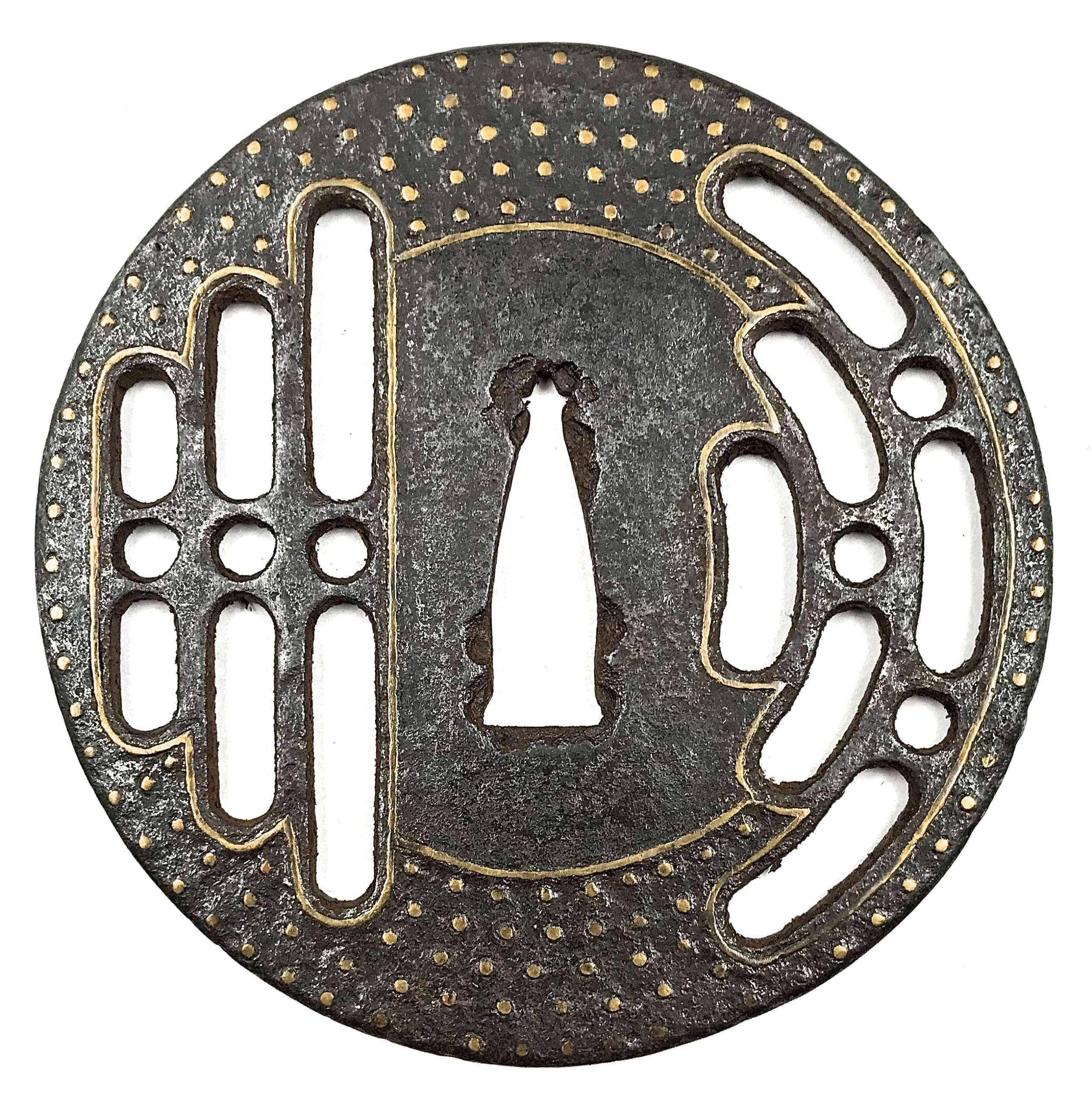 Reference to this design can be found in LIB-1359.2017 Japanese Swords and Tsuba from the Professor A. Z. Freeman and the Phyllis Sharpe Memorial collections, Sotheby's, London, Thursday 10 April 1997; p. 18-19, lot № 37: "A Kamakura-bori Tsuba, Momoyama Period. ...pierced with two large formalised butterflies..."
Reference to this design can be found in LIB-1359.2017 Japanese Swords and Tsuba from the Professor A. Z. Freeman and the Phyllis Sharpe Memorial collections, Sotheby's, London, Thursday 10 April 1997; p. 18-19, lot № 37: "A Kamakura-bori Tsuba, Momoyama Period. ...pierced with two large formalised butterflies..."
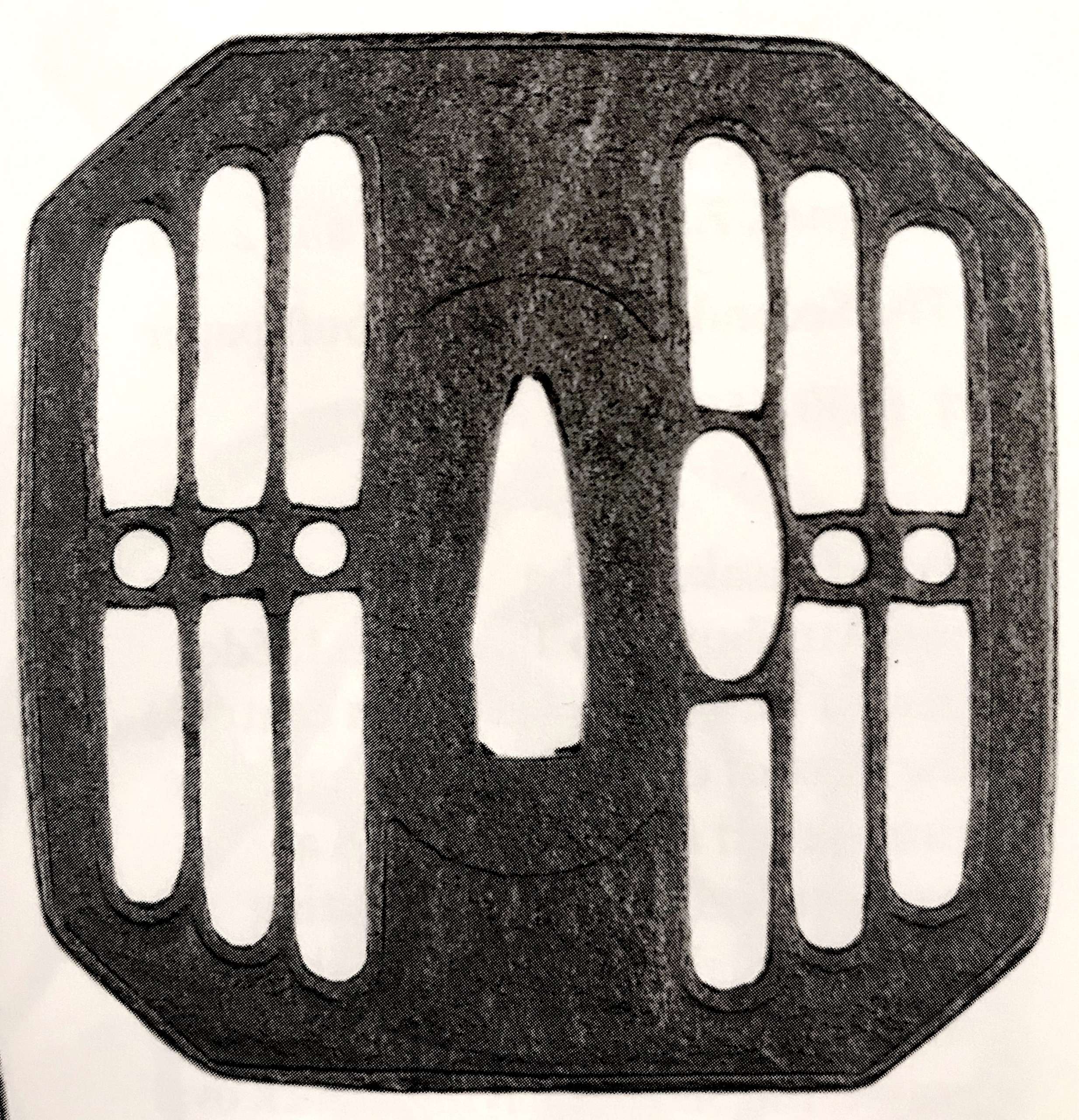
A Kamakura-bori tsuba of octagonal form, Momoyama period.
-
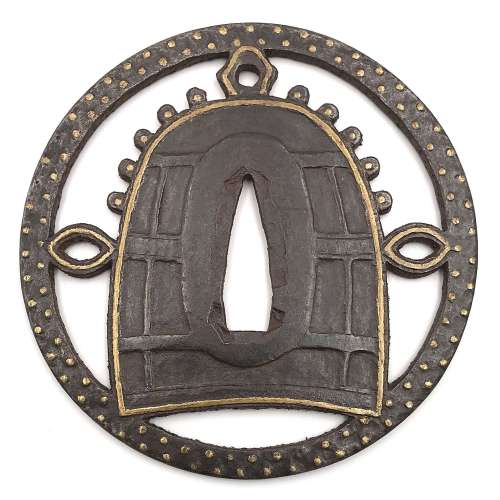
Iron tsuba of round form with brown patina decorated with the design of a Buddhist temple bell (tsurigane) in openwork (sukashi), with details outlined in brass wire (sen-zōgan), the outer ring decorated with two rows of brass dots (ten-zōgan), and the bell details carved in sukidashi-bori as on kamakura-bori pieces.
Ōnin school. Unsigned. Late Muromachi period, 16th century. Dimensions: 88.8 x 88.3 x 3.0 mm. As per Merrily Baird, two legends are usually associated with the image of tsurigane, a large, suspended Buddhist bell: one is that of Dojo Temple (Dojo-ji), and the other is of Benkei stealing the tsurigane of Miidera Temple. Interestingly, this type of bell (tsurigane) is not described as a family crest (mon), while suzu and hansho bells are. -
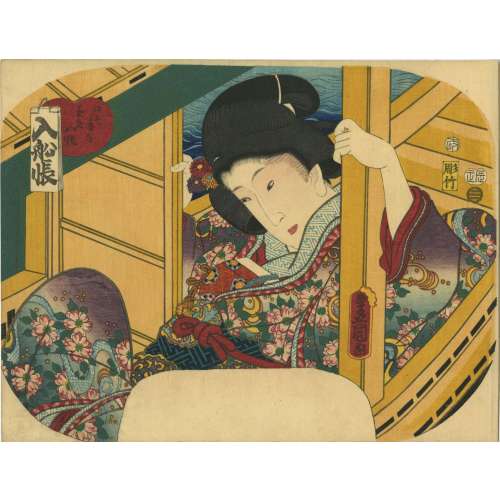 Artist: Utagawa Kunisada [歌川 国貞] a.k.a. Utagawa Toyokuni III [三代歌川豊国] (Japanese, 1786 – 1865). Block cutter: Yokokawa Takejirō [横川竹二郎] (Japanese, fl. 1845 – 1863), seal Hori Take [彫竹]. Publisher: Ibaya Senzaburō [伊場屋仙三郎] (Japanese, fl. C. 1845 – 1847). Title: Book of an incoming ship [入船帳] (Irifune-chō). Series: Comparison of Eight Books of Proficiency and Eloquence [口も手も美立八帳] (Kuchimo temo mitate hatchō). Date seal and aratame censor seal: 1856 (Ansei 3). Signed: Toyokuni ga in toshidama cartouche. Media: Untrimmed fan print (uchiwa-e), 231 x 300 mm. Provenance: The Collection of Paul F. Walter, Christie's, New York, 2017, lot 341; sold together with 5 other fan prints for $25,000. Before: Israel Goldman, Japanese Prints, Catalogue 11, 2005, no. 37. Ref: [LIB-1693.2018] The Collection of Paul Walter. — NY: Christie's, 2017, p. 363. Ref: Israel Goldman, Catalogue 2018, № 51: "Utagawa Kunisada (1786-1865) A Beauty Seated in a Boat. From the series Mitate hatcho (A Parody of Eight Books). 1856. Fan print. 23.3 x 30 cm. Provenance: Israel Goldman, Japanese Prints, Catalogue 11, 2005, no. 37, The Collection of Paul F. Walter, Christie's, New York, 2017, lot 341. Fine impression, colour and condition. The title contains the saying: “Kuchi mo hatcho te mo hatcho (As quick with one’s hand as one’s tongue)." Special thanks to Horst Graebner for the detailed description.
Artist: Utagawa Kunisada [歌川 国貞] a.k.a. Utagawa Toyokuni III [三代歌川豊国] (Japanese, 1786 – 1865). Block cutter: Yokokawa Takejirō [横川竹二郎] (Japanese, fl. 1845 – 1863), seal Hori Take [彫竹]. Publisher: Ibaya Senzaburō [伊場屋仙三郎] (Japanese, fl. C. 1845 – 1847). Title: Book of an incoming ship [入船帳] (Irifune-chō). Series: Comparison of Eight Books of Proficiency and Eloquence [口も手も美立八帳] (Kuchimo temo mitate hatchō). Date seal and aratame censor seal: 1856 (Ansei 3). Signed: Toyokuni ga in toshidama cartouche. Media: Untrimmed fan print (uchiwa-e), 231 x 300 mm. Provenance: The Collection of Paul F. Walter, Christie's, New York, 2017, lot 341; sold together with 5 other fan prints for $25,000. Before: Israel Goldman, Japanese Prints, Catalogue 11, 2005, no. 37. Ref: [LIB-1693.2018] The Collection of Paul Walter. — NY: Christie's, 2017, p. 363. Ref: Israel Goldman, Catalogue 2018, № 51: "Utagawa Kunisada (1786-1865) A Beauty Seated in a Boat. From the series Mitate hatcho (A Parody of Eight Books). 1856. Fan print. 23.3 x 30 cm. Provenance: Israel Goldman, Japanese Prints, Catalogue 11, 2005, no. 37, The Collection of Paul F. Walter, Christie's, New York, 2017, lot 341. Fine impression, colour and condition. The title contains the saying: “Kuchi mo hatcho te mo hatcho (As quick with one’s hand as one’s tongue)." Special thanks to Horst Graebner for the detailed description. -
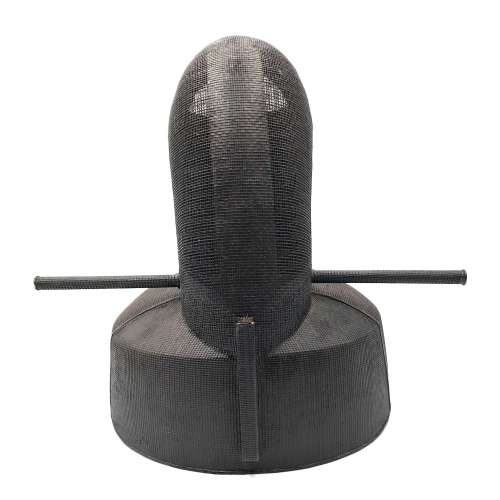 Kanmuri - a classic court cap, made of lacquered wood and paper. It is traditionally made by creating a skeleton, or harinuki, of paper on a wooden form. The outside of the hari-nuki is lacquered so as to keep its shape, and then the body of ra silk is layed on top. The entire thing is lacquered stiff.
Kanmuri - a classic court cap, made of lacquered wood and paper. It is traditionally made by creating a skeleton, or harinuki, of paper on a wooden form. The outside of the hari-nuki is lacquered so as to keep its shape, and then the body of ra silk is layed on top. The entire thing is lacquered stiff.Size: Height:20cm; Width: 21cm; Depth: 20cm.
Probably Taishō period (1912-1926), or later. Certain information is provided at http://www.sengokudaimyo.com/garb/garb.html In a wooden box without inscriptions. -
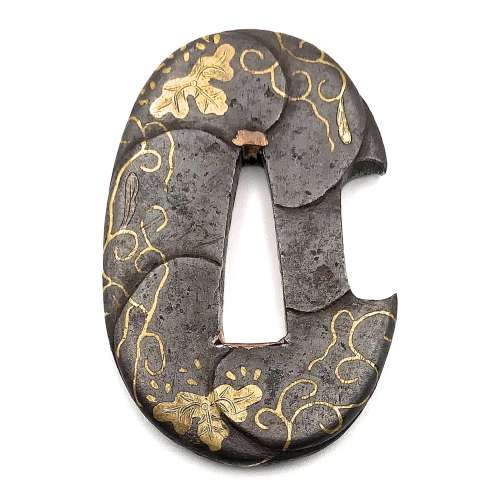
Small iron tsuba (tantō size) of oval form carved with imitation of six overlapping plates, decorated with paulownia blossoms, leaves, and tendrils in brass and copper hira-zōgan. Copper sekigane. Open kozuka hitsu-ana.
Early Edo period, 17th century.
Size: 50.5 x 34.0 x 4.9 mm.


